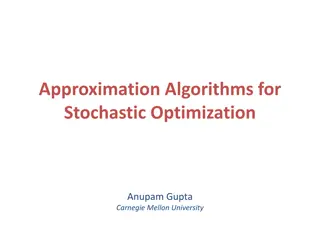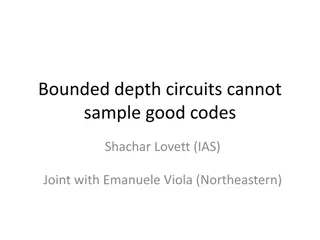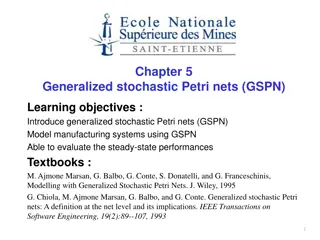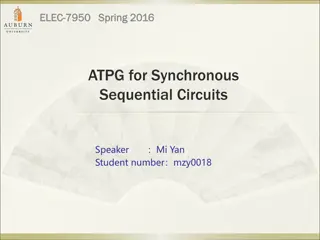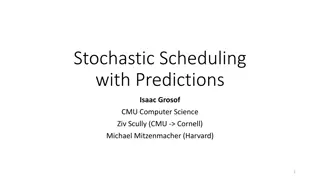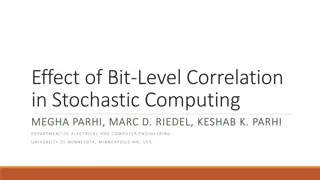
Innovative Polysynchronous Stochastic Circuits Approach
Explore the groundbreaking concept of polysynchronous stochastic circuits proposed by M. Hassan Najafi, David J. Lilja, Marc Riedel, and Kia Bazargan. Learn about the advantages of this approach in electronic systems, overcoming traditional design bottlenecks, and the implementation of stochastic computation to enhance circuit performance.
Download Presentation

Please find below an Image/Link to download the presentation.
The content on the website is provided AS IS for your information and personal use only. It may not be sold, licensed, or shared on other websites without obtaining consent from the author. If you encounter any issues during the download, it is possible that the publisher has removed the file from their server.
You are allowed to download the files provided on this website for personal or commercial use, subject to the condition that they are used lawfully. All files are the property of their respective owners.
The content on the website is provided AS IS for your information and personal use only. It may not be sold, licensed, or shared on other websites without obtaining consent from the author.
E N D
Presentation Transcript
Polysynchronous Stochastic Circuits M. Hassan Najafi, David J. Lilja, Marc Riedel, and Kia Bazargan {najaf011, lilja, mriedel, kia}@umn.edu ASP-DAC 2016
Overview Introduction Synchronous systems: CDNs a major design bottleneck Completely asynchronous, GALS Our proposed approach Polysynchronous stochastic Background Stochastic computation Basic Stochastic Operations with polysynchronous inputs Stochastic Circuits with Polysynchronous Inputs Experimental results High level simulation Circuit level simulation Conclusion 2 / 27 Polysynchronous Stochastic Circuits
Introduction Electronic systems are inherently asynchronous They can be adapted to behave synchronously Synchronism brings significant advantages: Simplifies the design effort, Performance guarantee But comes at a significant cost: Must create clock distribution network (CDN) A single clock signal arrival time (zero clock skew) CDNs are becoming a major design bottleneck Accounts for significant area, consumes significant power, limits the circuit performance Figure 1. A global CDN 3 / 27 Polysynchronous Stochastic Circuits
Introduction Completely asynchronous design methodologies Have been studied for decades have never gained widespread acceptance Globally asynchronous, but locally synchronous (GALS) Pros. reduces the cost of the distribution network By Splitting the domains Cons. complex circuitry for handshaking So splitting is only performed at a coarse level. 4 / 27 Polysynchronous Stochastic Circuits
Our proposed approach We propose a radically new approach: Splitting clock domains at a very fine level Domains consisting of only a handful of gates each Each domain is synchronized by an inexpensive clock signal, generated locally A ring of inverters. This is feasible by adopting a stochastic representation for signal values. 5 / 27 Polysynchronous Stochastic Circuits
Background: Stochastic Computation Logical computation is performed on random bit streams. The signal values are encoded by the probability of obtaining a one versus a zero. Unipolar encoding:? ? ? Each bit has probability ? of being 1 and 1 ? of being 0. Bipolar encoding: ? ? ? Each bit has probability ?+? ? of being 1 and 1 ?+? ? of being 0. Example. 11010, 00111, 1111001100, 0.6 in unipolar, 0.2 in bipolar 6 / 27 Polysynchronous Stochastic Circuits
Background: Stochastic Number Generator Stochastic Number Generator (SNG) To generate a stochastic bit stream with probability ? ?: 1. Obtain an unbiased random value r from random source physical random sources pseudo-random constructs such as LFSRs. 2. Compare it to the target value ? ?; 3. Output a 1 if ? ?and a 0 otherwise. Fig 6. Stochastic Number Generator 7 / 27 Polysynchronous Stochastic Circuits
Background: Stochastic Computation Complex operations can be performed with very simple logic. Multiplication: AND gate Scaled addition: MUX Figure 2. An example of multiplication using an AND gate Figure 3. An example of scaled addition using a MUX unit A reduction in area of 50x or 100x compared to conventional implementations is common. 8 / 27 Polysynchronous Stochastic Circuits
Background: Stochastic Computation Another advantage over binary radix: Error Tolerance In a noisy environment: With a binary representation in the worst case the most significant bit gets flipped => a large error. With a stochastic representation all the bits in the stream have equal weight. A single flip results in a small error. Stochastic representation is high error tolerant. 9 / 27 Polysynchronous Stochastic Circuits
Polysynchronous Stochastic A more compelling advantage: with a stochastic representation, computational units can tolerate skew Obviates the need for a global clock signal This stems from the fact: the stochastic representation is uniform All that matters: the fraction of time that the signal is high. The correct value is computed even when the inputs are misaligned temporally. polysynchronous stochastic 10 / 27 Polysynchronous Stochastic Circuits
Polysynchronous Stochastic Stochastic operations with polysynchronous inputs: Multiplication Fig 4. Stochastic multiplication using an AND with unsynchronized bit streams. Scaled addition Fig 5. Stochastic scaled addition using a MUX with unsynchronized bit streams. 11 / 27 Polysynchronous Stochastic Circuits
Basic Stochastic Operations with polysynchronous inputs Consider an AND gate, responsible for multiplying two input bit streams, P1 and P2 P1 and P2 are generated by SNGs driven by two clocks with different periods, T1 and T2. Simple case. We connect two clocks with periods of T1 and T2 to the inputs The inputs are both P=0.5 The expected output value is Y=0.25. We verify three different scenarios: 1) T1=2ns, T2=3.5ns, 2) T1=2ns, T2=3.2ns, 3) T1=1.8ns, T2=3.2ns. 12 / 27 Polysynchronous Stochastic Circuits
Basic Stochastic Operations with polysynchronous inputs Fig 7. Input clock signals and the corresponding output from connecting polysynchronous inputs to an AND gate. Table 1. Different observed lengths of high pulses at the output of the AND gate and the number of occurrences of each one for 1000ns. Temporal misalignment of input values does not affect the accuracy of the computation. 13 / 27 Polysynchronous Stochastic Circuits
Basic Stochastic Operations with polysynchronous inputs Functionality of a MUX unit performing scaled addition with temporally misaligned inputs. Table 2. The measured output of the MUX when threepolysynchronousclocks with distinct periods are connected to its inputs for 1000ns. Total High Time 499.43 500.21 498.80 499.23 Measured Output 0.499 0.500 0.499 0.499 Expected Output 0.500 0.500 0.500 0.500 T1(ns) T2(ns) T3(ns) 2.00 1.90 3.20 2.87 1.80 2.63 1.60 2.43 3.75 2.12 2.00 2.10 The measured output values are essentially equal to the expected output value of 0.5 (0.5 + 0.5)/2=0.5 14 / 27 Polysynchronous Stochastic Circuits
Basic Stochastic Operations with polysynchronous inputs General case. Table 3. Stochastic multiplication and scaled addition, using an AND gate and a MUX, with inputs generated by unsynchronized SNGs. AND Output Meas. 0.247 0.237 0.128 0.096 MUX Output Meas. 0.502 0.498 0.372 0.350 In1 0.50 0.35 0.27 0.18 T1(ns) 2.10 2.82 2.81 1.60 In2 0.50 0.66 0.48 0.53 T2(ns) T3(ns) 2.30 3.11 2.36 3.70 Expec. 0.250 0.231 0.129 0.095 Expec. 0.500 0.505 0.375 0.355 2.00 3.68 3.61 2.20 Results are based on bit streams of length 1024, generated with 32- bit LFSRs. In spite of the polysynchronous clocking, the results are accurate to within the error bound expected for stochastic computation. 15 / 27 Polysynchronous Stochastic Circuits
Stochastic Circuits with Polysynchronous Inputs ??,?=1 2 (1 2??,? ??+1,?+1+1 ? ? = ?0.45 2??,?+1 ??+1,?) Fig. 9. Stochastic implementation of the Gamma Correction function [2]. Fig. 8. Stochastic implementation of the Robert's cross edge detection algorithm [1]. [1] Peng Li, D.J. Lilja, Weikang Qian, K. Bazargan, and M.D. Riedel. Computation on stochastic bit streams digital image processing case studies. TVLSI 2014. [2] Weikang Qian, Xin Li, M.D. Riedel, K. Bazargan, and D.J. Lilja. An architecture for fault- tolerant computation with stochastic logic. IEEE Transactions on Computers, 2011. 16 / 27 Polysynchronous Stochastic Circuits
Stochastic Circuits with Polysynchronous Inputs Fig. 10.a. Basic Sorting Unit [1] Fig. 10.c. A stochastic implementation of a 3*3 Noise reduction median filter [1] Fig. 10.b. Stochastic implementation of the basic sorting unit [1]. [1] Peng Li, D.J. Lilja, Weikang Qian, K. Bazargan, and M.D. Riedel. Computation on stochastic bit streams digital image processing case studies. TVLSI 2014.] 17 / 27 Polysynchronous Stochastic Circuits
Stochastic Circuits with Polysynchronous Inputs Parallel processing of a 4x4 input image The input bit streams arriving from neighboring are generated by SNGs driven by their local clocks and so are all potentially misaligned temporally. Fig. 11. 16 Robert's Cross Cells processing a 4x4 input image concurrently. 18 / 27 Polysynchronous Stochastic Circuits
Experimental Results Circuits are implemented in Verilog, Simulation in Modelsim a 256*256 sample input image For the Robert's cross circuit, 3 out of 4 streams are received asynchronously For the Median Filtering circuit, 8 out of 9 streams are received asynchronously For the Gamma correction circuit, Bernstein coefficients streams are generated with SNGs driven by local clocks. For the SNGs: 32-bit maximal period LFSR, seeded with a random initial value for each trial, Bit streams of length 1024 19 / 27 Polysynchronous Stochastic Circuits
Experimental Results Generating a golden case All local clocks are synchronized (period of 2ns). Even with synchronized clocks there are some inaccuracy when comparing with the conventional binary outputs. Original image Median Filter 3.15% Robert s cross 2.88% Gamma 2.56% Fig. 12. The original sample image, and the outputs of processing the sample image using stochastic circuits working with synchronized local clocks. 20 / 27 Polysynchronous Stochastic Circuits
Experimental Results We compare 6 different clocking schemes Scheme 1. The period of the local clock in all processing cells Is fixed at 2ns (the golden case). Scheme 2. The period of the local clock in each cell a random real value between 2-3 ns So 50% variation between the clock periods. Scheme 3. The period of the local clock in each cell a random real value between 2-4ns so 100% variation. 21 / 27 Polysynchronous Stochastic Circuits
Experimental Results We compare 6 different clocking schemes Scheme 4. The periods of the local clocks random values between 2-4ns, but high output pulses that are less than 10% of the 2ns clock period (0.2ns) are filtered out (i.e., they are set to 0). Scheme 5. Same as Scheme 4, but we filter out high output pulses that are less than 15% of the 2ns clock period. Scheme 6. Same as Scheme 4, but we filter out high output pulses that are less than 20% of the 2ns clock period 22 / 27 Polysynchronous Stochastic Circuits
Experimental Results To produce more reliable results Simulate each circuit based on the six clocking schemes 10 times, each time with different initial conditions: 10 different LFSR seed values for each SNGs 10 different sets of values for the periods of the local clocks. We calculate the average output error rate as follows: 256 ?=1 256??,? ??,? ?=1 255.(256 256) ? = 100 23 / 27 Polysynchronous Stochastic Circuits
Experimental Results Table 4. The mean of the output error rates for the three implemented stochastic circuits, simulated in six different clocking schemes. Clocking Schemes S.3 2.94% 2.49% 3.31% S.1 S.2 S.4 S.5 S.6 Robert Gamma.. Median. 2.88% 2.56% 3.15% 2.89% 2.50% 3.19% 2.89% 2.51% 3.28% 2.92% 2.59% 3.39% 2.88% 2.64% 3.31% The accuracy of the computations is essentially independent of how synchronized the local clocks are. Polysynchrony might actually help instead of hurting! 24 / 27 Polysynchronous Stochastic Circuits
Experimental Results SPICE-Level Verification SPICE netlist of the Robert's cross circuit Simulation using 45-nm gate library in HSPICE 500 sets of random input values, For the conventional synchronous: clock periods =>1ns. For the polysynchronous: clock periods => random (1ns-2ns) On 500 trials, the mean of the output error rates were 4.91% for the synchronous approach. 4.42% for the polysynchronous approach. Polysynchronous stochastic circuits are essentially as accurate as conventional synchronous circuits. 25 / 27 Polysynchronous Stochastic Circuits
Conclusion We presented Polysynchronous Stochastic Computation As a proof of concept It is predicated on the paradigm of stochastic computing. Low cost, low power consumption, high resiliency Another important benefit of the stochastic paradigm the flexibility it provides for the clocking mechanism. Computation is accurate irrespective of the temporal alignment of input values, So it can tolerate arbitrary amounts of clock skew. We can remove the CDN and instead use Locally inexpensive generated clocks Improving area, power, and design complexity 26 / 27 Polysynchronous Stochastic Circuits
Thank you Questions? M. Hassan Najafi Najaf011@umn.edu 27 / 27 Polysynchronous Stochastic Circuits








